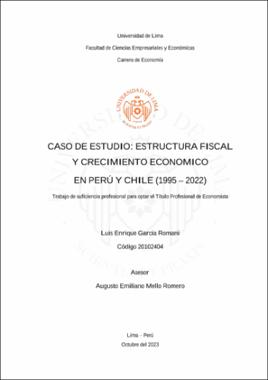Mostrar el registro sencillo del ítem
Caso de estudio: estructura fiscal y crecimiento económico en Perú y Chile (1995 – 2022)
| dc.contributor.advisor | Mello Romero, Augusto Emiliano | |
| dc.contributor.author | García Romani, Luis Enrique | |
| dc.date.accessioned | 2023-11-27T15:57:15Z | |
| dc.date.available | 2023-11-27T15:57:15Z | |
| dc.date.issued | 2023 | |
| dc.identifier.citation | García Romani, L. E. (2023). Caso de estudio: estructura fiscal y crecimiento económico en Perú y Chile (1995 – 2022) [Trabajo de suficiencia profesional para optar el título profesional de Economista, Universidad de Lima]. Repositorio institucional de la Universidad de Lima. https://hdl.handle.net/20.500.12724/19382 | es_PE |
| dc.identifier.uri | https://hdl.handle.net/20.500.12724/19382 | |
| dc.description.abstract | During the period from 1995 to 2022, Peru and Chile experienced diverse trends in fiscal policy and growth. In Peru, throughout this period, several reforms and fiscal adjustments were implemented in order to reduce fiscal deficits and maintain debt sustainability, objectives that were mainly driven by the mining and construction sectors. Chile, on the other hand, maintained a more stable fiscal policy, with an approach characterized by fiscal discipline and macroeconomic stability and, likewise, its growth was supported by commodity prices and an increase in foreign investment. The objective of this paper is to evaluate to what extent the tax structure has an effect on economic growth in Peru and Chile during the selected period. Therefore, we seek to answer questions such as: ¿What is the extent of the effect of taxes on consumption, capital and labor on growth? Representing the later as productivity. Likewise, ¿Which tax exerts the greatest influence? and whether there is indeed a significant relationship between the tax structure and the selected endogenous. Ultimately, we seek to demonstrate the feasibility of measuring the impact of the tax structure on growth, despite the complexities associated with this type of estimation. Finally, we obtain results that, although they vary in certain aspects with the values obtained from the studies on which we based ourselves, they are significant and allow us to achieve an adequate interpretation of the tax variables, as well as to demonstrate a relationship between economic growth and the tax structure. | en_EN |
| dc.description.abstract | Durante el periodo de 1995 al 2022, Perú y Chile experimentaron tendencias diversas en política fiscal y crecimiento. En el Perú, a lo largo de este periodo, se implementaron diversas reformas y ajustes fiscales con el fin de reducir déficits fiscales y mantener la sostenibilidad de la deuda, objetivos que fueron impulsados principalmente por los sectores de minería y construcción. Chile, por su lado, mantuvo una política fiscal más estable, con un enfoque que se caracterizó en mantener una disciplina fiscal y estabilidad macroeconómica y, al igual que Perú, su crecimiento se vio apoyado por el precio de los commodities y un aumento de las inversiones extranjeras. El presente trabajo tiene como objetivo evaluar en qué medida la estructura tributaria tiene efectos en el crecimiento económico de Perú y Chile durante el periodo seleccionado. Por ello, buscamos responder a preguntas tales como: ¿Cuál es alcance del efecto de los impuestos al consumo, capital y trabajo sobre el crecimiento? Representado éste último, como productividad. Asimismo, ¿Qué impuesto ejerce la mayor influencia? y si efectivamente, existe una relación significativa entre la estructura tributaria y la variable endógena seleccionada. En última instancia, buscamos demostrar la viabilidad de medir el impacto de la estructura fiscal en el crecimiento, a pesar de las complejidades asociadas a este tipo de estimación. Finalmente se obtienen resultados que, si bien varían en ciertos aspectos con los valores obtenidos de los estudios en los que nos basamos, presentan significancia y nos permiten lograr una interpretación adecuada de las variables tributarias, así como evidenciar una relación entre el crecimiento económico y la estructura fiscal. | es_PE |
| dc.format | application/pdf | |
| dc.language.iso | spa | |
| dc.publisher | Universidad de Lima | |
| dc.rights | info:eu-repo/semantics/openAccess | * |
| dc.rights.uri | https://creativecommons.org/licenses/by-nc-sa/4.0/ | * |
| dc.source | Repositorio Institucional - Ulima | es_PE |
| dc.source | Universidad de Lima | es_PE |
| dc.subject | Política fiscal | es_PE |
| dc.subject | Impuestos | es_PE |
| dc.subject | Desarrollo económico | es_PE |
| dc.subject | Perú | es_PE |
| dc.subject | Chile | es_PE |
| dc.subject | Fiscal policy | es_PE |
| dc.subject | Taxation | es_PE |
| dc.subject | Economic development | es_PE |
| dc.title | Caso de estudio: estructura fiscal y crecimiento económico en Perú y Chile (1995 – 2022) | es_PE |
| dc.title.alternative | Case study: Tax structure and economic growth in Peru and Chile (1995-2022) | en_EN |
| dc.type | info:eu-repo/semantics/bachelorThesis | |
| thesis.degree.level | Título Profesional | es_PE |
| thesis.degree.discipline | Economía | es_PE |
| thesis.degree.grantor | Universidad de Lima. Facultad de Ciencias Empresariales y Económicas | es_PE |
| dc.publisher.country | PE | |
| dc.type.other | Trabajo de suficiencia profesional | |
| thesis.degree.name | Economista | es_PE |
| renati.advisor.orcid | https://orcid.org/0000-0003-0464-2089 | |
| renati.discipline | 311016 | |
| renati.author.dni | 72839814 | |
| renati.level | https://purl.org/pe-repo/renati/level#tituloProfesional | * |
| renati.advisor.dni | 7588028 | |
| renati.juror | Del Castillo Vargas, Julio Cesar | |
| renati.juror | Penny Pestana, Javier Bernardo | |
| renati.juror | Mello Romero, Augusto Emiliano | |
| renati.type | https://purl.org/pe-repo/renati/type#trabajoDeSuficienciaProfesional | * |
| dc.subject.ocde | https://purl.org/pe-repo/ocde/ford#5.02.01 | |
| ulima.lineadeinvestigacion | 5300 – 5.g1 | |
| ulima.cat | 15 |





